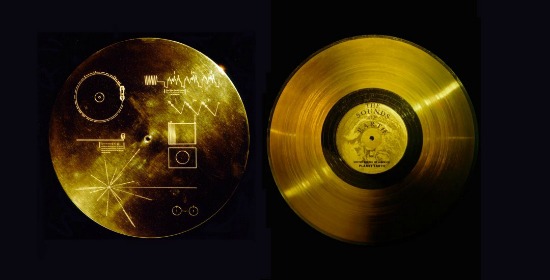![]()

The cover and record "The Sounds of Earth," included aboard the Voyager 1 and 2 probes. Photos courtesy of the Air and Space Museum.
If, billions of years from now, extraterrestrials were to come across one of our far-flung interstellar space probes, what could they learn of us? In the 1970s, as NASA prepared to send its first probes beyond the distant reaches of the solar system, this was the question that worried renowned scientist and author Carl Sagan.
Sagan, who died 15 years ago on this day, was enormously influential in a number of ways—he was a prolific researcher and publisher of articles on planetary science, and his books and popular PBS series Cosmos inspired a generation with the remarkable discoveries of astronomy and astrophysics. But his most long-lasting and significant impact might indeed be the time capsule he placed on the NASA probes: a gold-plated record titled “The Sounds of Earth.”
“From the beginning, Sagan was a strong believer in the probability that there is intelligent life out there,” says Jim Zimbelman, a geologist at the Air and Space Museum, which holds a replica of the gold record in its collection. “And because of that, he said, ‘Look, these are the first man-made objects to leave the solar system. What if someone finds them?’”
Sagan was instrumental in having small metal plaques attached to Pioneers 10 and 11, the first probes to leave the solar system, that would theoretically indicate to extraterrestrials the origin of the probe if ever discovered. But for Voyagers 1 and 2—a pair of spacecraft designed to survey Jupiter, Saturn, Uranus and Neptune—he and others wanted something more comprehensive: a record of images and sounds that would represent the diversity of the human experience.

Sagan initiated the decision to put a time capsule of humanity aboard the Voyager space probes. Photo courtesy of NASA.
“How do you do that—how do you capture the world in the a few pictures? That was the challenge,” says Zimbelman. ”On the selection panel, they included historians, artists and people specializing in literature. They just wanted to get a smattering of human culture preserved on the record.” Sagan chaired the committee and presided over the selection process.
Ultimately, 116 images and sounds made it through the selection process and were included on “The Sounds of Earth.” “There are hundreds of digitized images on there, of everything from tribal peoples in Africa to a modern city,” Zimbelman says. Greetings were recorded in 55 different languages, and accompanied by a diverse musical selection with everything from Bach to traditional Peruvian music to Chuck Berry.
Perhaps even more difficult than selecting content for the record was devising a way to help distant, unimaginable life forms figure out how to play it. “The scientists all agreed that they needed to use some timing feature that was not only here on earth, or even in the solar system,” Zimbelman says.
The panel decided to base the speed at which the record should be rotated upon a characteristic of the hydrogen atom. “The atom can be in two different states, and when it transitions from one to the other, it happens in a characteristic time period—its a very small fraction of a billionth of a second,” Zimbelman says. Inscribed upon the metal cover of the record is a series of diagrams that attempt to communicate playing instructions based on this timing. Although critics have argued that extraterrestrials would find these pictures utterly mystifying, they represent the best attempts by scientists to convey information without using any language or conventions of human culture.
At the Air and Space Museum, a full-scale replica of the two Voyager spacecrafts is on view in the Exploring the Planets gallery, and an interactive display allows visitors to see some of the images and hear some of the sounds included on the golden record. Parts of the replica were used in pre-engineering tests before the probes were launched.
Meanwhile, more than 34 years after their 1977 launches, the Voyagers are still in the early stages of their journeys, hurtling through limitless space with the gold records safely aboard. After flying by the outer planets of the solar system, they are now traveling beyond its outer reaches—Voyager 1 is 120 times further from the sun than Earth is, and Voyager 2 is about 98 times further.
Given enough time, they just might reach other star systems and perhaps even other planets. And if extraterrestrial life forms happen upon them, thanks to Sagan, they just might be able to learn a little bit about life on earth. But, Zimbelman cautions, we need not hold our breath—nothing is happening anytime soon. ”Voyager 1 will get within a light year of a star about 40,000 years from now,” says Zimbelman. “It’s very, very long-term.”
Fonte: http://blogs.smithsonianmag.com
Posted By: Joseph Stromberg — Air and Space Museum
No comments:
Post a Comment
Note: Only a member of this blog may post a comment.